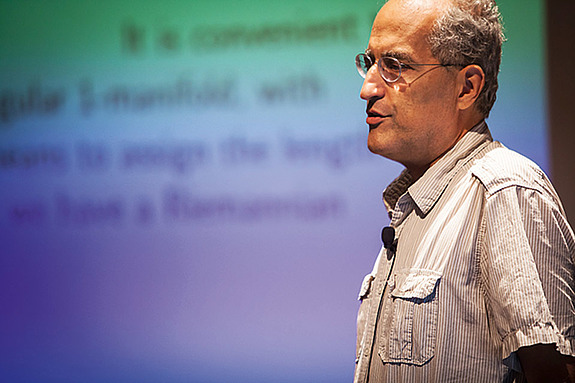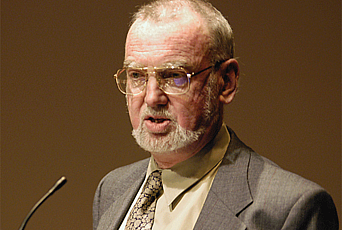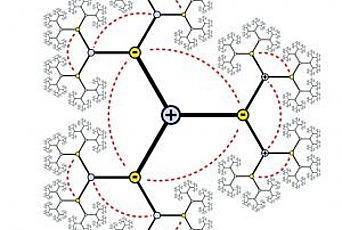Geometric Langlands, Khovanov Homology, String Theory

In 2006, Edward Witten, Charles Simonyi Professor in the School of Natural Sciences, cowrote with Anton Kapustin a 225-page paper, “Electric-Magnetic Duality and the Geometric Langlands Program,” on the relation of part of the geometric Langlands program to ideas of the duality between electricity and magnetism.
Some background about the Langlands program: In 1967, Robert Langlands, now Professor Emeritus in the School of Mathematics, wrote a seventeen-page handwritten letter to André Weil, a Professor at the Institute at the time, in which he proposed a grand unifying theory that relates seemingly unrelated concepts in number theory, algebraic geometry, and the theory of automorphic forms. A typed copy of the letter, made at Weil’s request for easier reading, circulated widely among mathematicians in the late 1960s and 1970s, and for more than four decades, mathematicians have been working on its conjectures, known collectively as the Langlands program.
Witten spoke about his experience writing the paper with Kapustin and his thoughts about future directions in mathematics and physics in an interview that took place in November 2014 on the occasion of Witten’s receipt of the 2014 Kyoto Prize in Basic Sciences for his outstanding contributions to mathematical science through his exploration of superstring theory. The following excerpts are drawn from a slightly edited version of the interview conducted by Hirosi Ooguri, Member (1988–89) and Visiting Professor (2015) in the School of Natural Sciences, which was published in the May 2015 issue of Notices of the American Mathematical Society (www.ams.org/notices/201505/ rnoti-p491.pdf).1
It was very hard to write a paper about it. It took about a year. For that year, I felt like someone who had discovered the meaning of life and couldn’t explain it to anybody else. And in a sense, I still feel that way for the following reason. Physicists with a background in string theory or gauge theory dualities can understand my paper with Kapustin on geometric Langlands, but for most physicists, this topic is too detailed to be really exciting. On the other hand, it is an exciting topic for mathematicians but difficult to understand because too much of the quantum field theory and string theory background is unfamiliar (and difficult to formulate rigorously). That paper with Kapustin may unfortunately remain mysterious to mathematicians for quite some time.
I think it’s actually very difficult to see what advance in the near term could make the gauge theory interpretation of geometric Langlands accessible for mathematicians. That’s actually one reason why I’m excited about Khovanov homology. My approaches to Khovanov homology and to geometric Langlands use many of the same ingredients, but in the case of Khovanov homology, I think it is quite feasible that mathematicians could understand this approach in the near future if they get excited about it. I believe it will be more accessible. If I had to bet, I think I have a decent chance to live to see gauge theory and Khovanov homology recognized and appreciated by mathematicians, and I think I’d have to be lucky to see that in the case of gauge theory and the geometric Langlands correspondence—just a personal guess. A lot of things that number theorists like have appeared in physics, and some have even appeared in my own work. Plenty has been found to show that the physics theories that we work on as string theorists are interesting in number theory. These theories know something about number theory, but personally I don’t see an opportunity to really make contact in a structural way with number theory in the foreseeable future. I can’t even formulate what it would mean to make such contact, so I can’t even properly tell you what we can’t do, but I think the time is not right to do it.Anyway, that’s why I personally concentrated on geometric Langlands rather than on number theory, and geometric Langlands was hard enough. It was a lot of work to understand it, but I think that having understood it, many things that mathematicians do involving geometric aspects of representation theory are much more accessible as part of physics. . . . In the last few years physicists working on supersymmetric gauge theories in four dimensions and their cousins in six dimensions have made several discoveries involving the role of conformal field theory at the critical level, so the time may well be right to resolve this point.
In the last twenty years, not only has this interaction of math and physics continued to be very rich, but it has developed in such diversity that very frequently exciting things are done which I myself am able to understand embarrassingly little about, because the field is expanding in so many directions.
I am sure that this is going to continue and I believe the reason it will continue is that quantum field theory and string theory, I believe, somehow have rich mathematical secrets. When some of these secrets come to the surface, they often come as surprises to physicists, because we do not really understand string theory properly as physics—we do not understand the core ideas behind it. At an even more basic level, the mathematicians are still not able to fully come to grips with quantum field theory and therefore things coming from it are surprises. So for both of those reasons, I think that the physics and math ideas generated are going to be surprising for a long time.
I think there are definitely exciting opportunities for young people to come and help explain what it all means. We don’t understand this properly. We got a wider perspective in the 1990s when it became clear that the different string theories are unified by nonperturbative dualities and that string theory in some sense is inherently quantum mechanical.
But we’re still studying many different aspects of a subject whose core underlying principles are not clear. As long as that is true, there are opportunities for even bigger discoveries by today’s young people. But if I could tell you exactly what direction you had to go in, I would be there.
1 The interview originally appeared in the December 2014 issue of Kavli IPMU News, the news publication of the Kavli Institute for the Physics and Mathematics of the Universe (Kavli IPMU) of the University of Tokyo, and was conducted by Kavli IPMU’s Principal Investigator Hirosi Ooguri, Fred Kavli Professor of Theoretical Physics and Mathematics and Founding Director of the Walter Burke Institute for Theoretical Physics at the California Institute of Technology.


